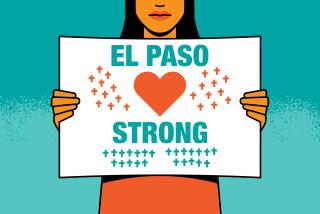Review of ‘Texas’ Fails to Set the Record Straight
- Share via
In his eagerness to savage “Texas,” ABC’s version of the James A. Michener novel, Howard Rosenberg becomes military historian and decides to set the Alamo record straight--once and for all! (“There’s a Lot to Question in This History of ‘Tex” Calendar, April 14). As an antidote to “Texas” as “history through the eyes of white people,” Rosenberg enlists the talents of Rodolfo Acuna, author of “Occupied America: A History of Chicanos.”
The center of the Rosenberg-Acuna expose seems to be: 1) Alamo defenders really didn’t have will and heart; 2) the Mexican army was an ill-prepared, ragtag group with inferior weapons and not half as many cannon as their opponents, while 3) the Americans were well-armed, concealed, crack-shooting professional soldiers.
Yet, according to virtually all contemporaneous and scholarly accounts, the Alamo defenders had remarkable will and heart. An eyewitness (Louis Moses Rose, the only fighter to escape the Alamo massacre) describes Lt. Col. William Barrett Travis, the commander, telling the garrison of the hopelessness of their lot, drawing a line in the dirt with his sword, and asking those who would stay and fight to cross the line, while those who would escape not. Only Rose chose escape.
While it is true that nearly half the Mexican attackers (6,000-6,500) were the reluctant result of the sorteo, a kind of draft (more a kidnaping), the remainder were permanentes, or regulars, with battle experience. Mexican forces were armed with British .753-calibre “Brown Bess” muskets that were lethal up to 100 yards. (It was a ball from a Brown Bess that mortally wounded Travis during the first minutes of the assault.)
As for artillery, Gen. Antonio Lopez de Santa Anna’s army actually had more guns than the Alamo defenders, 21 vs. 18. And although the general’s refusal to wait a day or two for his heavy 18-pounders to come forward resulted in unnecessary Mexican casualties, his 9-pounders battered the Alamo walls for nearly two weeks. The defenders, on the other hand, had neither the men (crew of five needed for each of 18 guns) nor the ammunition to use each of the pieces (“ . . . limited to touching off artillery round only three or four times a day,” according to Jeff Lang’s “Duel of Eagles: Mexican and U.S. Fight for the Alamo”).
The Mexicans were poorly led--at least at the top. Yet many of the soldiers had far more combat experience than the Americans, and while most of the Mexican officers were careerists, the American officers can be characterized as “amateurs posing as officers” (so wrote Col. James F. Fannin, himself a West Point dropout, who just days after the fall of the Alamo was captured at Goliad, only to be slaughtered--along with some 400-500 other Americans--by Santa Anna’s express written order).
Were the Americans well-armed? No. Stephen Austin wrote (in one of 16 pleas for help): “We have more men than guns.” And Noah Smithwick, a blacksmith, stated, “I fixed up many an old gun that I wouldn’t have picked up in the road” (“Evolution of a State” by Noah Smithwick).
Despite Rosenberg’s contention that American crack shots with much-vaunted long rifles were picking off Mexicans, the fact is the attack began at 5 a.m. and lasted some 20 minutes when it was still dark. And after initial volleys, it was too smoky to offer either visibility or advantage to so-called sharpshooters. If anything, the long rifle was a liability because a bayonet could not be mounted on it--a distinct handicap in the hand-to-hand fighting to come. The attackers did not suffer this disadvantage, and were all armed with the bayonet that they put to bloody use (including the murder--again at the express order of Santa Anna--of the only Alamo defenders taken alive, Davy Crockett and six others).
Acuna protests that the Americans were professional soldiers. Again, no! Of the 180 odd (variously given as 183-189) Alamo defenders, nearly all were volunteers signed up for a three-month hitch. It wasn’t until Feb. 3 (barely a month earlier) that Travis recruited his little group in San Antonio. Worse, almost a fifth of the force was sick. (Jim Bowie is thought to have died just hours before the attack.) Still worse, the only doctor, Amos Pollard, had exhausted his supply of medicine (“Fall of the Alamo,” John Sutherland).
Much more could (should) be said about the fractured history served the reader by Rosenberg and Acuna. For example, the Alamo, itself, lacked even the rudimentary requirements of a fort. In fact, other than crumbling adobe and limestone walls, little distinguished it as a defensive point--a “fort,” in short, breached in 20 minutes.
One of Santa Anna’s own senior officers, Lt. Col. (later Brig. Gen.) Jose Enrique de la Pena, described as one of the best and brightest, writes (“With Santa Anna in Texas”):
“Travis behaved like a hero; one must do him justice, for with a handful of men without discipline, he resolved to face men used to war and much superior in numbers, without supplies, with scarce munitions and against the will of his subordinates.”
You know, this sounds almost heroic. Yet, what the hey, if Rosenberg doesn’t like it, let him write his own history.


